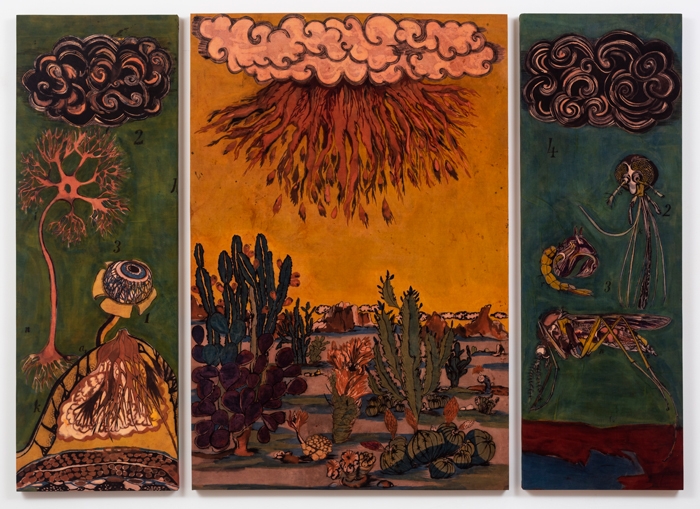Oh! Chintzy, chintzy cheeriness, the narrator remarks in John Betjeman’s ode to talced decease and decay in a West Midlands nursing home, ‘Death in Leamington’ (1932). What a far cry from chintz’s origins in the Indian decorative technique of kalamkari. That.exhaustive process, which can require more than 20 steps, involves soaking cotton in cow dung and buffalo milk, outlining an image using fermented jaggery, filling it in with natural dyes and washing it like you’re auditioning to play Lady Macbeth. Lavanya Mani adapts this traditionally male practice, coupling it with other craft techniques and philosopher Donna Haraway’s vision for the ‘Chthulucene’ – the nonhierarchical, cross-species modes of coexistence that she has posited as an alternative to the Anthropocene – to suture together a cautionary tale of ecological catastrophe.
Here the flood has already arrived, in the shape of a circular, wax-resisted piece of fabric pooling at the centre of the gallery. An A-frame tent is pitched upon it, open at both ends and with elaborate designs on either side of the fabric shelter: on one, animals clamber up a tree to escape rising waters, on the other we see sky and sea teeming with avian and marine life. Its title, The Ark: Animals of the world complain to the Raven (after Miskin) (all works 2018–19), gestures to the myriad mythological, historical and theoretical references present in this show, from the biblical flood to the sixteenth-century Mughal court painter Miskin, who was known for his depictions of animals. Looping in one corner of the multiroom gallery is a video depicting indigo’s reactions with five other natural dyes – extracted from dates, turnips, sweet potato, madder, henna – each in its own beaker. Like India’s own rather bloody colonial history, in which indigo played a crucial role, the admixed dyes take a long time to sediment and settle. The slow accretion results in six blurrily dystopian landscapes that evoke other modes of destruction. The acid-green of nuclear devastation, perhaps, or the dim red tide of a dying sun.
Elsewhere in the exhibition, across eight or so largescale works of stretched cotton fabric variously dyed, appliquéd and embroidered, insects and fungi seem to plot their own strategies of world domination – feeding on decay to recolonise the ground in Improbable Planet, or hovering ominously over a tentative new shoot in Parasite. Or is it repair and renewal? The show’s palette is at once rich and muted in its natural tones, all saffrons, ochres, olives and burgundies. A generalised jaundicing contributes to the overall sense of decay. Despite the warm palette, the effect is seductively sci-fi, invoking nothing so much as the Gaian faction of the videogame Sid Meier’s Alpha Centauri (1999).
Whatever the narrative poison, our impending terracide haunts this show. But it is tempered by scenes of multispecies cooperation and the generalised resilience of nonhuman life in the large, wall-hung fabric paintings that round out the show. In Herbarium 1 (From the Medicine Mountain) a volcano is blowing, but inside its rocky walls is a lush jungle of tropical birds, white blooms and assorted ferns. In the triptych No Man’s Land, the central panel shows clouds breathing fire onto cacti clinging to a scrubby wasteland, while hybridised alien forms thrive underwater in the side panels. Another triptych, Auguries (From The Conference of the Birds), similarly depicts a central panel that is aflame while a veritable conference of birds hover and preen on the sides. There are no humans anywhere in sight. History and climate change suggest that this is maybe for the best.
Lavanya Mani: Signs Taken for Wonders at Chemould Prescott Road, Mumbai, 14 March – 30 April 2019
From the Summer 2019 issue of ArtReview
